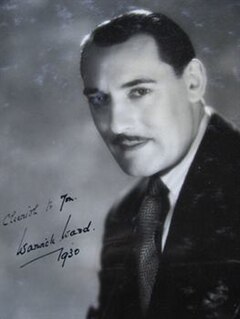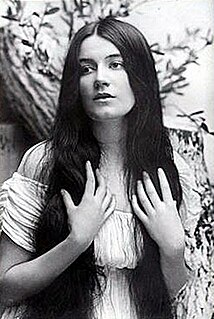
Goldwyn Pictures Corporation was an American motion picture production company that operated from 1916 to 1924 when it was merged with two other production companies to form the major studio, Metro-Goldwyn-Mayer. It was founded on November 19, 1916, by Samuel Goldfish better known as Samuel Goldwyn, an executive at Paramount ) partnering with Broadway producers Edgar and Archibald Selwyn using an amalgamation of both last names to create the name.

Charles G. Rosher, A.S.C. was a two-time English-born Academy Award-winning cinematographer who worked from the early days of silent films through the 1950s.

Helen Dunbar was an American theatrical performer and silent film actress.
Maurice Elvey was one of the most prolific film directors in British history. He directed nearly 200 films between 1913 and 1957. During the silent film era he directed as many as twenty films per year. He also produced more than fifty films - his own as well as films directed by others.

Warwick Ward was an English actor of the stage and screen, and a film producer. He appeared in more than 60 films between 1919 and 1933. He also produced 19 films between 1931 and 1958. He was born in St. Ives, Cornwall.

Guy Newall was a British actor, screenwriter and film director. He was born on the Isle of Wight on 25 May 1885. He began his film career by acting in the 1915 film The Heart of Sister Ann. In 1920 he directed his first film, and went on to direct a further ten including The Chinese Puzzle before his death in 1937. He established a production company with George Clark whom he had met during the First World War, and they raised finance to construct a new studios at Beaconsfield Studios. Newall was married twice, to actresses Ivy Duke and Dorothy Batley.

Gerald Ames was a British actor, film director and Olympic fencer. Ames was born in Blackheath, London in 1880 and first took up acting in 1905. He was a popular leading man in the post-First World War cinema, appearing in more than sixty films between his debut in 1914 and his retirement from the screen in 1928 in a career entirely encompassing the silent era. He was also a regular stage actor who took on many leading roles in the theatre.

Stewart Rome was an English actor who appeared in more than 150 films between 1913 and 1950.

Violet Hopson was an actress and producer who achieved fame on the British stage and in British silent films. She was born Elma Kate Victoria Karkeek in Port Augusta, South Australia on 16 December 1887. Violet Hopson was her stage name, while in childhood she was known as Kate or Kitty to her family.
Arthur Walcott (1857–1934) was a British actor of the silent era.
The Merchant of Venice is a 1916 British silent drama film directed by Walter West and starring Matheson Lang, Hutin Britton, Ernest Caselli. It is an adaptation of William Shakespeare's play The Merchant of Venice.
Hepworth Picture Plays was a British film production company active during the silent era. Founded in 1897 by the cinema pioneer Cecil Hepworth, it was based at Walton Studios west of London.
The Ideal Film Company was a British film production and distribution company that operated between 1911 and 1934.
Anglo-Hollandia was a British-Dutch film production company which operated between 1919 and 1923 during the silent film era. It had its roots in the existing Dutch company Hollandia Films, and attempted to produce films with appeal to both Britain and the Netherlands.
Catford Studios was a British film studio located in Catford in Southeast London which operated from 1914 to 1921. It was also known as the Windsor Studios.
Broadwest or the Broadwest Film Company was a British film production company of the silent era. Its name it a portmanteau of its two founders, George Broadbridge and the film director Walter West. West took an active role in the company's productions, directing and producing many of the films. The company gained a reputation for producing films about horse racing, often based on popular novels such as those of Nathaniel Gould.
The Esher Studios were a British film studio located in Esher in Surrey. The studios opened in 1913 during the silent era. The studios were built by a company that included the director Warwick Buckland, but the failure of their films led to the sale of the site to Walter West's Broadwest. Broadwest later switched most of its filming to Walthamstow Studios. The studios continued to be used occasionally by independent filmmakers into the 1920s.

Frank Wilson (1873–?), was a British actor, writer and film director. Wilson was a prolific director during the silent era, shooting well over 200 shorts and feature films. He worked at the pioneering Hepworth Pictures in Walton Studios and later at Broadwest of Walthamstow Studios.

Selznick Pictures was an American film production company active between 1916 and 1923 during the silent era.
Arrow Film Corporation was an American film production and distribution company during the silent era from 1915 to 1926. An independent company it operated alongside the established studios. Originally formed to supply films for Pathé Exchange, the company quickly separated and concentrated on a mixture of medium and low-budget productions. The company was sometimes referred to as Arrow Pictures.









